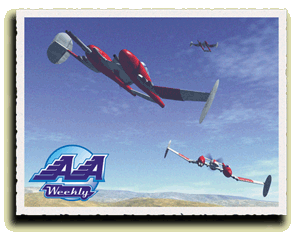
 |
|
||||||||||||||||
 |

Aircraft In Review 
Featured Aircraft: The William & Colt Peacemaker 370 Introduced shortly after the secession of the Republic of Texas from the United States-and that nation's subsequent conflict with Mexico-the William and Colt Peacemaker 370 has been one of Texas' most recognized aircraft, featured in comic strips and pulp novels as the definitive Texan warplane. Ironically, the Peacemaker was only produced in small numbers, with fewer than 200 in service (mostly operated by the Texas Rangers and the Texas Air Force). The remainder of operational Peacemakers are scattered between local militias in Texas, Arixo and Free Colorado…and a number of pirate bands (most notably, "Marshal" Bill Redmann, Texas' most famous outlaw). Early this week, William and Colt, the manufacturer of the Peacemaker, has announced plans to upgrade production of this unusual aircraft, in a few different configurations. W&C has received permission from the Texas government to sell the new Peacemakers abroad-generating hard currency for the Lone Star Republic, as well as swelling the ranks of the Rangers and the Texas Air Force. William And Colt NAAC was forced to sell off most of its plants and manufacturing centers, launching the careers of several smaller aircraft firms. One such site, in Dallas, was purchased by local industrialists, Bruce William and Benjamin Colt (a descendant of noted gunsmith and entrepreneur, Sam Colt). With Texas' secession (and the subsequent call for arms to defend the Republic against Mexico), William and Colt designed their first aircraft, a heavy fighter. The design was a failure, but despite the setback and lack of interest from the Texas military, the pair persevered, turning out the first airworthy Peacemaker in June of 1932. Despite some initial hiccups in the Peacemaker design (such as problems with the engine mounting), the first 50 Peacemakers were immediately purchased by the Texas government. The Peacemaker 370 Design Disadvantages In a test flight of a stock Peacemaker, I was singularly unimpressed with the craft; as a dogfighter, the Peacemaker is a flying coffin. It turns too slow, it accelerates poorly, and visibility afforded by the offset cockpit is difficult to get used to. Design Advantages The Peacemaker possesses a serious weapons load-out: four .60-caliber cannons and eight rocket hardpoints are the standard munitions load. And the Peacemaker's stability and low stall speed make it a useful, and hard-hitting, low-altitude fighter. Even better, the "new" Peacemakers (with upgraded engines, delivering an extra 30 m.p.h.) come in a number of "flavors," each suited to various mission profiles. The New Breed of Peacemaker Evaluation
|